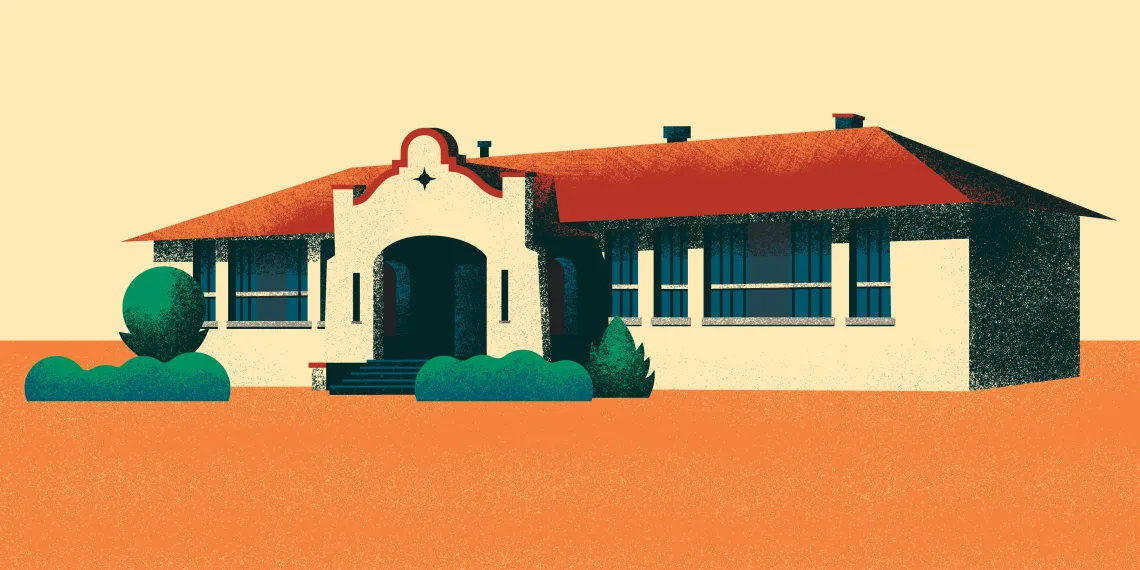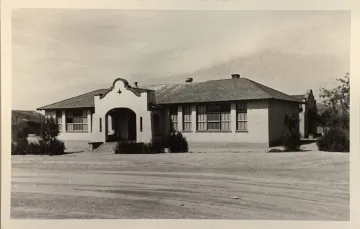Tucson Communities of Color Preserve a Piece of Black History with Support from UArizona
UArizona lends support with a $100,000 grant and faculty collaborators as Tucson’s Dunbar Pavilion—a former segregated school—evolves into a revitalized community center where Black history is remembered, and all are welcome.

The Dunbar School as it appeared ca. the 1950s
(Graphic by Eddie Canto/RII)
If buildings could speak, Tucson’s Dunbar Pavilion might say: “Because you love me I have much achieved.” It’s the first line in “Encouraged,” a poem by the building’s namesake, 20th century Black American poet Paul Laurence Dunbar.
Last year, the Dunbar Coalition, a nonprofit that has transformed the former segregated Dunbar School into a community center, was awarded a two-year, $100,000 grant from the Agnese Nelms Haury Program in Environment and Social Justice at the University of Arizona. In conjunction with the university’s Center for Regional Food Studies (CRFS), El Rio Health Centers, and the African American Coalition for Health and Wellness, the coalition is using the funds to create educational health and wellness programming.
“We witness the power of the community aspirations combined with UArizona practice-based research in this project,” Nancy Petersen, Haury program manager, said. “It’s about so much more than community classes. It’s linking shared heritage and space to support community, while embracing history for healing and rejuvenation. The Dunbar Pavilion shows us how societal change begins.”
In 2017, the College of Social and Behavioral Sciences entered a partnership with the Dunbar Coalition and hired Debi Chess as a Community Impact Fellow for two years. During that time, Chess and Megan Carney, director of the CRFS, wrote the Haury grant proposal. Chess has since become the interim executive director of the Dunbar Coalition where she works alongside Barbara Lewis, a Dunbar School alumna and vice president of the coalition.
“We want to provide a space for Black arts and culture, but we also want everyone—Hispanics, Whites, Asians, whoever—to be welcome here. We want to show that we’re better than the way we were treated,” Lewis said.
A History in Brief
From 1913 to 1951, nearly every Black student in Tucson attended the Dunbar School, the city’s segregated school for Black students in grades K-9. The school’s motto: “Be the best.” The school was renamed John Spring Junior High School upon integrating in 1951. In 1978, its doors closed. For almost two decades, the building—located off Stone Avenue and 2nd Street—sat empty, deteriorating into a neighborhood eyesore. Every window was shattered, and its ceilings caved in. Only raccoons, feral cats and vermin roamed its echoic halls. By the 1990s, the dilapidated, odious building was scheduled for demolition.
In 1996, two of its alumni banded together with the Tucson Juneteenth Committee, the Tucson Urban League, and the Dunbar/Spring Neighborhood Association to buy the building from the Tucson Unified School District for $25. At the time, their mission was simple and short: Save the school from being torn down, then fix it up. After the purchase, the alumni founded the Dunbar Coalition and began restoring the building, now called the Dunbar Pavilion.
Today the building is on the National Register of Historic Places.

The Dunbar School ca. the 1950s
Photo courtesy of the Dunbar Coalition
The UArizona Connection
Now in its second year of Haury funding, the Dunbar Pavilion hosts free, public workshops several times a month. Many are interactive, with participants cooking and eating and exercising (not all at once).
Patrisia Gonzales, associate professor in Mexican American Studies in the College of Social and Behavioral Sciences, has hosted two workshops: “Heart Medicine for People of Color” and “Restore & Chillax.” She will host her third in April, “The Flower Body: Re-balancing the 4 Elements,” for which there is a wait list.
A third-generation traditional healer of the indigenous Kickapoo and Nahuas people of Mexico, Gonzales teaches courses such as Mexican Traditional Medicine at UArizona.
In her community workshops, Gonzales uses plants growing in the Dunbar Pavilion’s community farm, such as citrus blossoms, and rosemary and other plants commonly used by home cooks to “help people connect to the natural world and their bodies based on traditional concepts of my family’s lineage of medicine from the Nahua-speaking peoples of Mexico.”
Gonzales is also working alongside The Drawing Studio, a local nonprofit, to lead a team of adult students who are creating an interactive plant catalog of the Dunbar Pavilion’s community farm. The catalogue will include illustrations of each plant and provide information about its history and traditional medicinal uses.
“The Dunbar is a very unique place of both trauma and resilience. Here Tucson’s Black community transcended great inequality and injustice to survive and flourish,” Gonzales said. “I think it’s particularly important that they now have a space to practice health, wellness, and self-care.”
In another project, Tani Sanchez, associate professor in Africana Studies, is creating the second edition of a historical cookbook titled Meals and Memoirs: Recipes and Recollections of African Americans in Tucson, Arizona.
Sanchez was raised in Tucson and attended the John Spring School. Her mother, the late Marguerite Sanchez, was a teacher at the original Dunbar School.
“The Dunbar is a space that I’m intimately connected to,” said Sanchez, who is now a member of the Tucson Black Film Club which holds its meetings at the Dunbar Pavilion.
In the 1990s, Sanchez was the president of Tucson’s now defunct chapter of the Afro-American Genealogical and Historical Society. As president, she suggested that the chapter create a historical cookbook and use it to raise funds. As she edited the book—a collection of traditional African American recipes from Tucsonans who were “the movers and shakers of the 40s and 50s” and autobiographical essays about Black life in Tucson—Sanchez fell in love with its contents. She bought the permissions to reproduce it.
Only two hard copies remain of the first edition, and she had long wanted to produce a second edition by the time the Dunbar Coalition caught wind of the book and called Sanchez.
In the book’s “Cakes and Sweet Things” section, there are two sweet potato pie recipes, which “have a treasured place in African American tradition,” according to Sanchez. She has baked for her church using both recipes. Sanchez’s favorite essay in the book, “A Tucsonan Remembers Life in the Thirties,” was written by Marjorie Hudson Robinson, a UArizona alumna whose father was a teacher at the Dunbar School.
“These essays aren’t long, elaborate histories,” Sanchez said. “It’s just people writing about what they remember. I could read Marjorie’s essay over and over and over again.”
The new edition will incorporate about 20 new health-conscious recipes, footnotes on how to modernize traditional recipes, an essay about the role of food in the Black community and perhaps a few more autobiographical essays. When it’s published, Sanchez envisions it being sold in bookstores like the one at the Arizona Historical Society, at the Dunbar Pavilion, and maybe even on Amazon.
As the Dunbar Coalition continues to create new programs and resources for the community, it’s also focused on preserving its past. A former classroom is being converted into a research library and museum for its remaining archives—archives that will rely heavily on the recollections and old belongings of the school’s alumni.
Remembrance and Reunion
Since 1987, the school has hosted a two-day biannual reunion. About 200 alumni attended the first one, which cost $5 to attend and was held at a local hotel. Two years ago, 70 alumni attended the reunion held at the Dunbar Pavilion.
“Obviously, attendance has declined over the years because our youngest alumni are 75 years old,” Lewis said.
This year, 15 alumni attended, and they weren’t there just to socialize.
They offered their oral histories, recorded by Jamie Lee, an associate professor in the School of Information, and two graduate students, Stephanie “Gia” Del Pino, studying art and visual culture education, and Joanna Sanchez-Avila, studying rhetoric, composition, and the teaching of English. Lewis and Marya McQuirter, an assistant professor in the Department of History, wrote the 39 questions to ask alumni such as, “What did your family do for recreation?” and “What do you remember about your parents?”
Donald Lander drives to the reunion from Arcadia, Calif., and speaks as a small microphone captures his voice and all the memories it carries. To Lander, it’s his life. But from a grander perspective, it’s Tucson’s Black history—and it will be available to all who seek it.
Volunteers from UArizona’s Special Collections, including Head of Special Collections Verónica Reyes-Escudero, three graduate students, and one undergraduate, are on hand to organize and digitize old photos and documents brought in by alumni. These materials will be archived in the Dunbar Pavilion’s research library as well as in Special Collections.
In One Alumna, Dunbar’s Past and Present
While she’ll allow it for history’s sake, Barbara Lewis doesn’t need a server to store her memories. She does just fine on her own.

A class photograph featuring Barbara Lewis, standing in the row second from the bottom, third from the left
Photo courtesy of the Dunbar Coalition
She attended the school from 1942 to 1950, from first to eighth grade. The office she now works in used to be the school’s cafeteria. Her favorite meal was chili beans and cornbread, served only on Thursdays.
Lewis rode in from her family’s west-side home on one of the school’s two buses. Some days, her father would drive her to school.
Lewis was bright, but loquacious: “I spent a lot of time in the principal’s office because of that.”
She sang in the school’s award-winning acapella chorus. In theater, she was a natural on the stage. She was great at spelling. She recalls once not being able to spell “Yosemite” at a bee: “I was so embarrassed and so hurt because I let the school down.”
Her mother, a cosmetologist who talked constantly about health and beauty, made sure that Lewis was always on trend, with short, perfectly rolled bangs and smart plaid dresses in flattering cuts.
In fourth grade, Lewis had two boyfriends: First Burt. Then Ed. Then Burt again. Burt had a winning smile.
Lewis’s favorite teacher was Ollie Davenport, who taught the poetry of Paul Laurence Dunbar in dialect.
“I love the Dunbar,” Lewis said, offering an oral history of her own.
“I’m 82 years old. I’m here because I refuse to leave until I know that it’s on solid ground,” she said. “This is where African American children went to school. It was the only school where African American teachers could teach. We’re making sure that Black history isn’t erased from Tucson.” With one hand, Lewis wipes away a single tear. With the other, she wags a finger: “And you’re not going to make me cry about it.”
EXTRA INFO
WHAT: The UArizona Center for Regional Food Studies is hosting a Spring Speaker Series in collaboration with the Dunbar Pavilion and the Coalition for African American Health & Wellness. This month’s public talk will be given by Karen Washington, a community activist, co-founder of Black Urban Growers, and co-owner of Rise & Root Farm in Chester, New York. Washington’s talk is titled “Food Justice is about more than Growing Food and Feeding People.”
WHERE: Dunbar Pavilion Auditorium
WHEN: February 18 at 5:00 p.m.

